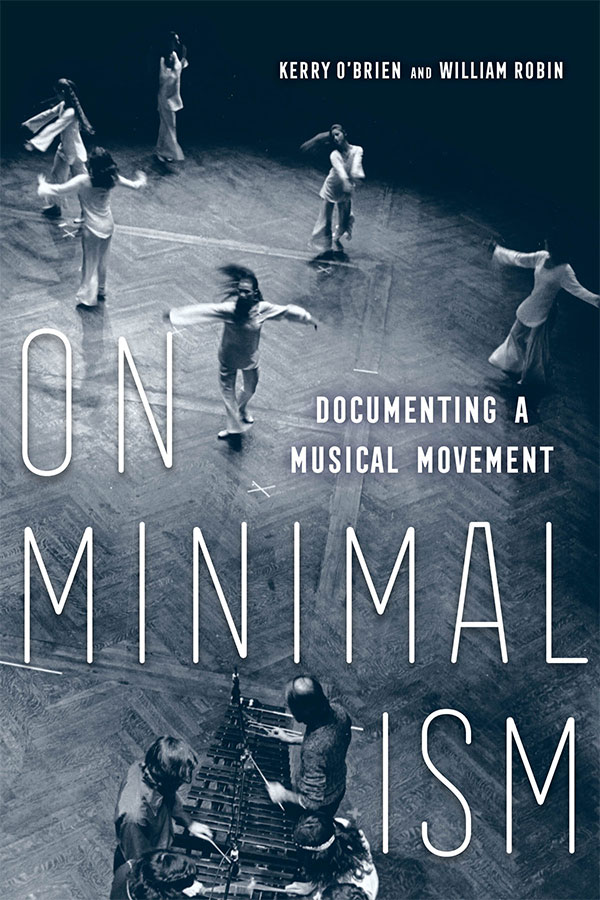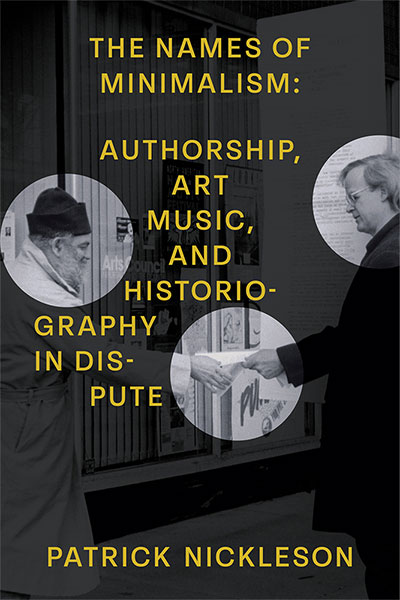On Minimalism. Documenting a Musical Movement, eds. Kerry O’Brien and William Robin (University of California Press)
The Names of Minimalism: Authorship, Art Music, and Historiography in Dispute, Patrick Nickleson (University of Michigan Press)

On Minimalism is a glorious compendium of loosely grouped reviews, album sleeve and liner notes, articles and interviews. It’s remit is wide and inclusive and all the better for that. Part One moves from an intriguing start where Miles Davis, John Coltrane, Yoko Ono and John Cage (performing Erik Satie) are predecessors of La Monte Young’s sustained drones, which then spawns Philip Glass, Steve Reich, the very wonderful Mother Mallard’s Portable Masterpiece, and early works by Meredith Monk. Their early work is gathered under the title ‘Loops and Process’, whilst Jon Hassell, Pauline Oliveros, Laraaji and Éliane Radigue are considered under ‘Altered States’, with an early (1973) example of the word ‘trance’ being used as well as ideas of healing and chanting and ‘celestial vibration’.
Meditation and a devotional religious music are the focus of a chapter on ‘Gurus and Teachers’, which leads neatly to a chapter on ‘Cultural Fusion’. Both chapters feature Alice Coltrane, whilst the liner notes to Don Cherry’s Organic Music LP in the second chapter are especially revealing. The first part ends by taking a step back to look ‘Across the Arts’, before a closing chapter ‘Ensembles’ engages with three of the by then well-established minimalist composers and their groups: Steve Reich, Meredith Monk and Philip Glass. Willoughby Sharp’s interviews with the members of the Glass Ensemble are especially revealing and interesting; information straight from the horse’s mouth, as it were.
Part Two of the book charts the widening impact and mutation of minimalism, particularly engaging with the New York Downtown scene, where Glenn Branca and Rhys Chatham’s loud and noisy ensembles are dismissed by John Cage in an interview with Wim Mertens, but the likes of Lee Ranaldo from Sonic Youth, Peter Zummo, Julius Eastman and Arthur Russell also hang out. Elsewhere, others are more concerned with ‘Instruments and Environments’ or drifting into ‘Ambient and New Age’ music, where – of course – we find Brian Eno being interviewed, as well as pianist Harold Budd.
There are questions and discussions of the ‘Canons’ of minimalism, including a very funny, satirical piece by Tom Johnson, from the Village Voice, in response to the question ‘What is Minimalism Really About?’, and also three argumentative and opinionated pieces of writing from the ‘Backlash’. Following an engaging chapter on ‘Politics, Identity and Expression’, which returns to the neglected Julian Eastman, alongside a discussion of a 1976 concert tour by Philip Glass, an introduction to John Adams, and Steve Reich’s explanation of the ideas behind ‘Different Trains’ (including childhood train travel but also Nazi trains loaded with Jews en route to concentration camps), there is a weaker and unfocussed chapter on ‘Postminimalism’. It remains a vague undefined term here, although it does include a short piece on Ingram Marshall’s music by John Adams.
The next two chapters also seem vague in focus and are probably the chapters many readers (this one, anyway) will question regarding their somewhat tenuous links to minimalism, even in its most inclusive and open forms. ‘Spiritual Minimalism’ concerns itself with what John Rockwell in the New York Times calls ‘mystical minimalism’: the vague, ethereal music of Henryk Górecki and Arvo Pärt; whilst ‘Popular Culture’ moves to the late 1970s and discusses how disco and techno were influenced by, and might even be part of, minimalism. I’m not convinced: stating that ‘[t]he very essence of disco is surrender to rhythm’ seems fair enough (if you’re dancing, anyway) but much of what is considered minimalism elsewhere in this book is not about surrendering to anything, it is about change and duration and effect. And suggesting that ‘Chic’s producers, Bernard Edwards and Nile Rodgers, are the ultimate examples of disco producers as environmental designers’ merely seems pretentious. Thankfully, the likes of Aphex Twin are on hand to cut through the crap: ‘I’m a fucking twat, mucking around on my computers.’
Part Three offers a trio of chapters: ‘Histories’, ‘Silences’ and ‘Futures’, where the obligatory questioning and revisionist versions of minimalism are offered up to the reader. The ongoing squabble between various members (including John Cale) of La Monte Young’s Theatre of Eternal Music (more on this later), another (well-deserved) argument for the inclusion of Julian Eastman and David Toop’s somewhat tangential and very speculative ‘notes towards a diasporic mixtape: black minimalism’, which open-heartedly includes dub, blues, funk, rock, acid house and hi-life. All good music, none of it very likely to be regarded as minimalism though.
‘Silences’ in a way builds upon the idea of minimalism being made up of little (rather than highlighting small changes), perhaps following routes from and through John Cage, Brian Eno, Pärt and Górecki. Jürg Frey suggests that ‘Music consists of sound; unchanging and unchanged, it expands in space. Attention is not trained on the individual event but wanders in space, laying claim to space just as sound does.’, whilst Eva-Maria Houben offers up ‘[s]ome thoughts on the perception of “nearly nothing”, including organising situations (compositions) where ‘[t]he listener will find the way to listening.’
The ‘Futures’ section seems a little unfocussed, or perhaps it’s just my aversion to Sunn O))) and ‘ambient jazz’, two of the four futures on offer here. Thankfully, there is a brief closing piece by Éliane Radigue to send the reader on their way, which is followed by a concise but useful playlist pertaining to each chapter. The 450 pages of documentation gathered here are a fabulous resource which make for a stimulating and at times provocative read. It’s not, of course, one to read through from cover to cover, more a kind of encyclopaedia to inform, entertain and challenge the reader.

In some ways, Patrick Nickleson’s book, The Names of Minimalism, is similarly wide-ranging and generously inclusive in its discussion, but it is hampered by being a very traditional academic discussion of its topic, which means it tries to compartmentalize and to formulate clear conclusions. A lot of this book is about whether the musicians in the likes of La Monte Young’s band are simply playing his compositions, or the fact that they are basically improvising sustained drones using just intonation, microtonal differences and overtones means they are co-composers. It’s an unanswerable question, and although one feels for Tony Conrad and John Cale, it’s really only the fact that La Monte Young is argumentative, unmoveable and physically owns most of the tapes that there is a debate still continuing. The somewhat abstract discussion of authorship and Nickleson’s contention ‘that the Theatre of Eternal Music functioned in its short time as a deliberative, collective community of equal “composer”-performers’ will not change the situation.
More interesting is the author’s discussion of ‘The Lessons of the Minimalism’ which considers ‘The Big Four and the Pedagogic Myth’, the big four of course being Glass, Riley, Reich and Young. Nickleson questions the perceived, tidied up and homogenised versions of history that have been formulated around these guys, but also the very term ‘minimalism’ which he suggests should be differentiated from ‘minimal’. On the back of this rather technical or semantic difference we get the ridiculous suggestion that the likes of Talking Heads and the Ramones were something to do with minimalism. Whether or not Melody Maker once referred to ‘the infectious minimalism of the Ramones’ seems beside the point. I really don’t think there was any connection implied.
More interesting is the further discussion of ‘Indistinct Minimalism’ which covers Rhys Chatham and the Downtown scene, and how music was presented at this time in artist’s spaces. Unfortunately, the book descends into impenetrable academic-speak in its final pages, with sentences like this: ‘Early minimalism, like a metonymic historiography, stages indistinction and contingent relationships not as problems to be solved dialectically, but as structures to be exacerbated precisely in the narrational works of emplotment.’ It’s a rather sorry end to a strange discussion of music, which worries far too much about what gets called what or is attributable to whom rather than the music itself. Personally, I’m not going to worry about these issues but instead enjoy what O’Brien and Robin have gathered together in On Minimalism.
Rupert Loydell
